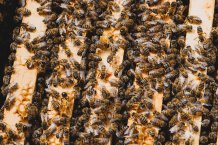Articles

The researchers created a new statistical technique to analyse data on bees
Scientists reveal core genes involved in honey bee immunity
An international team of researchers has identified a core set of genes involved in the responses of honey bees to multiple diseases caused by viruses and parasites.
The findings provide a better-defined starting point for future studies of honey bee health, and may help scientists and beekeepers to breed honey bees that are more resilient.
"In the past decade, honey bee populations have experienced severe and persistent losses across the Northern Hemisphere, mainly due to the effects of pathogens, such as fungi and viruses," said Dr Vincent Doublet, a postdoctoral research fellow at the University of Exeter’s Penryn Campus in Cornwall.
“The genes that we identified offer new possibilities for the generation of honey bee stocks that are resistant to these pathogens.”
According to the researchers, recent advances in DNA sequencing have prompted numerous investigations of the genes involved in honey bee responses to pathogens.
But until now this vast quantity of data has been too cumbersome to reveal overarching patterns in honey bee immunity.
"While many studies have used genomic approaches to understand how bees respond to viruses and parasites, it has been difficult to compare across these studies to find the core genes and pathways that help the bee fight off stressors," said Christina Grozinger, Distinguished Professor of Entomology at Penn State in the US.
"Our team created a new bioinformatics tool that has enabled us to integrate information from 19 different genomic datasets to identify the key genes involved in honey bees’ response to diseases."
Specifically, the team of 28 researchers, representing eight countries, created a new statistical technique which they termed “directed rank-product analysis”.
The technique allowed them to identify the genes that were expressed similarly across the 19 datasets, rather than just the genes that were expressed more than others within a dataset.
The scientists found that these similarly expressed genes included those that encode proteins responsible for the response to tissue damage by pathogens, and those that encode enzymes involved in the metabolism of carbohydrates from food, among many others.
A decrease in the latter, they suggested, may illustrate the cost of the infection on the organism.
The findings appear in the journal BMC Genomics.
This research was supported by iDiv, the German Center for Integrative Biodiversity Research, located in Leipzig, Germany.
Date: 2 March 2017
